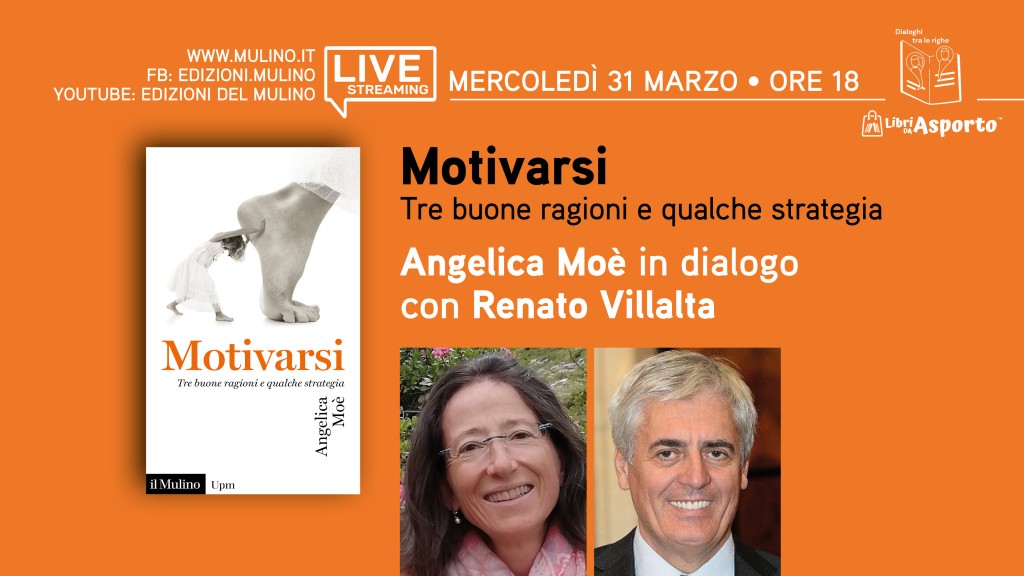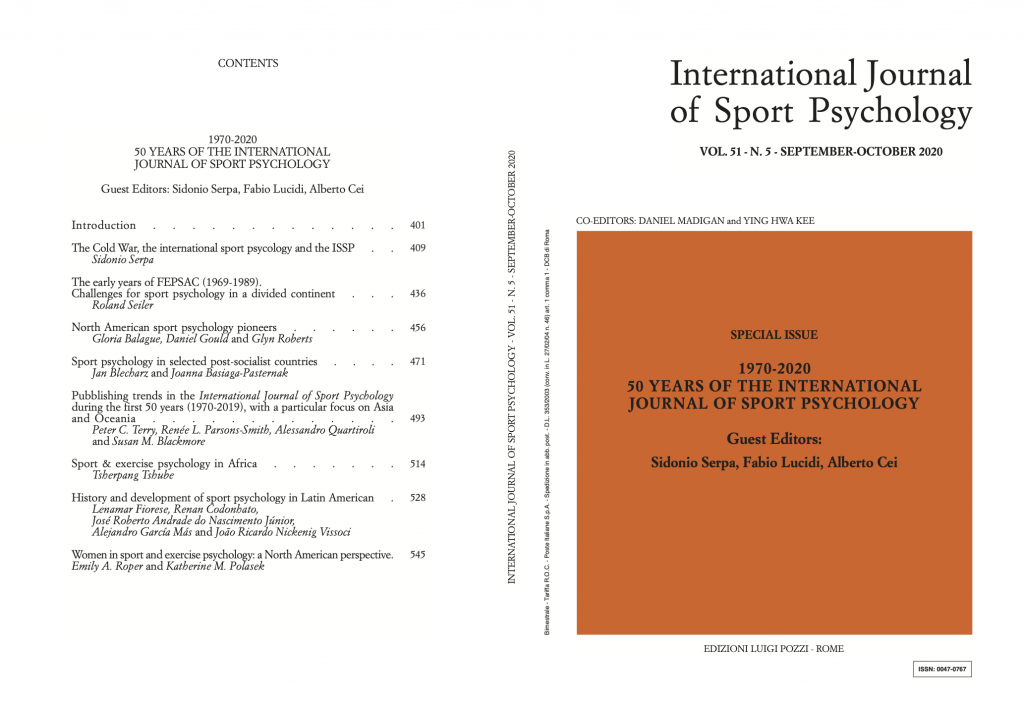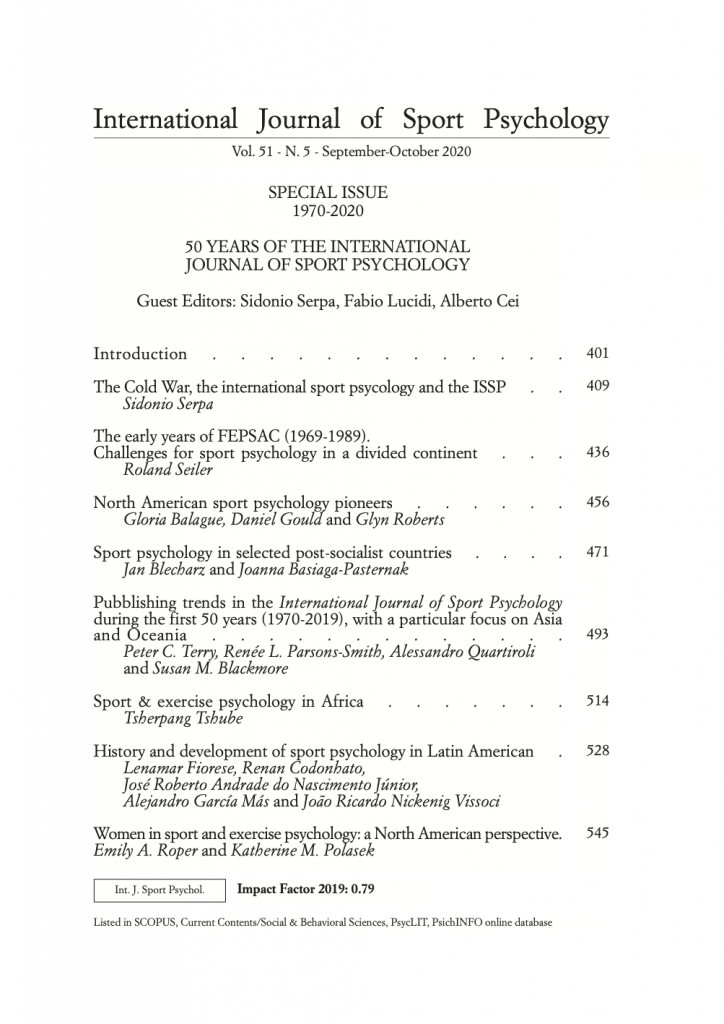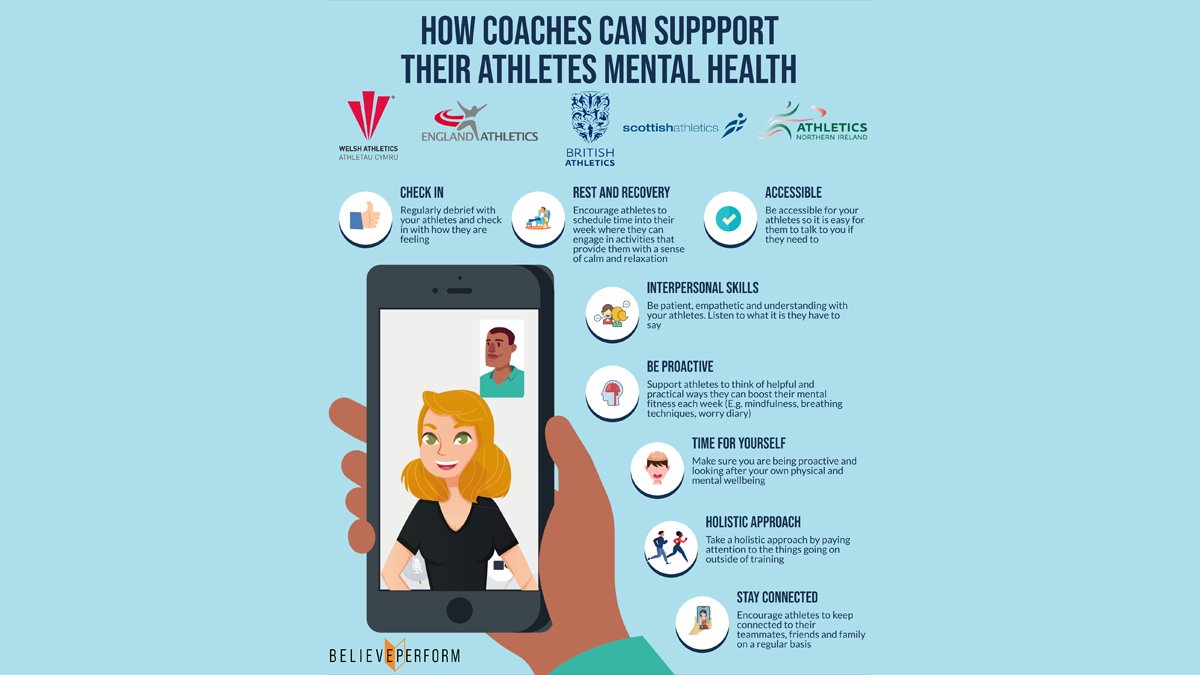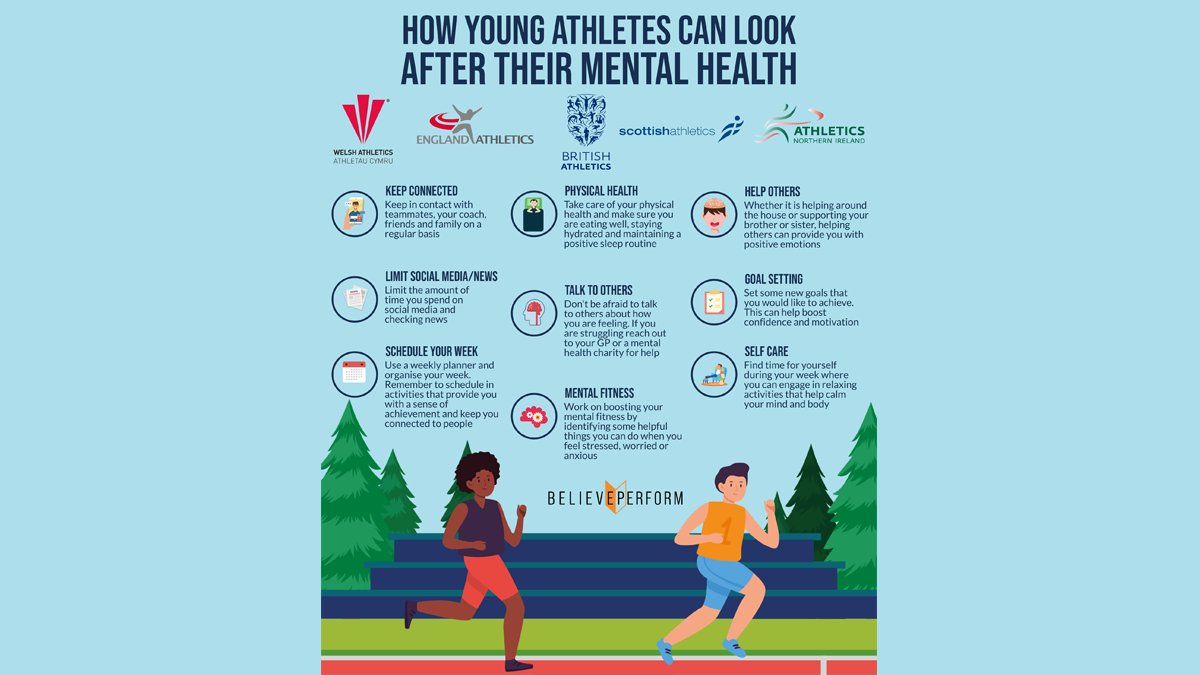Renato Villalta with the Italian basketball team played 207 games, ranking 7th in the attendance chart and scoring 2265 points, 3rd overall among scorers; he participated in the 1980 Moscow Olympics, winning the silver medal, after losing the final 77-86 against Yugoslavia. In 1983 in France, in Limoges, again with the National team, he won the gold medal at the European Championships and the silver medal at the Mediterranean Games. In 1984, together with his national teammates, he finished in 5th place at the Los Angeles Olympics. In 1985 he gained another medal at the European Championships in Germany, winning the bronze medal behind the USSR and Czechoslovakia. The following year, at the World Championships in Spain, the team placed sixth.
Archive for the 'Libri' Category
Page 4 of 12
2° SPECIAL ISSUE 1970-2020
50 YEARS OF THE INTERNATIONAL JOURNAL OF SPORT PSYCHOLOGY
Guest Editors: Sidonio Serpa, Fabio Lucidi, Alberto Cei
Fifty years with the International Journal of Sport Psychology.
From the history of sport psychology to its actual pathways
ALBERTO CEI, FABIO LUCIDI, SIDÓNIO SERPA
Fifty years after its appearance as the very first journal specifically com- mitted to sport psychology, the International Journal of Sport Psychology (IJSP) is today a well reputed and well established scientific journal. Aimed at both researchers and practitioners, the papers published are often not just of academic interest, but also have practical applications too.
After the first special issue looking back at the history of sport psychology, with this second issue we are interested to reflect about contemporary sport psychology and the actual role of the IJSP as a peer reviewed journal publishing and circulating research findings and theoretical speculation from sport psychologist over five continents (both scientists and practitioners) to learn from and build upon.
The aim of this second special issue is than to underline how the historical background showed in the previous issue leaded sport psychology toward actual pathways, focusing on some new trends of research, as well as on the reorientation of some classic topics according to the society changes. Through the contribution of some invited scholars, the present issue would make a point trying to understand what changes sport psychology is facing, or has to face, in relation to some main issues.
Youth sport research: Describing the integrated dynamic elements of the personal assets framework
JEAN CÔTÉ, JENNIFER TURNNIDGE, ALEX MURATA, CAILIE S. MCGUIRE and LUC J. MARTIN
This critical review of the youth sport literature provides a guiding framework to inform future studies and interventions aimed at understanding or manipulating mechanisms proposed to explain youth athlete development. A global vision of ath- lete development is presented through the interactions of three dynamic elements: (1) appropriate settings, (2) quality social dynamics, and (3) personal engagement in activities. These elements are further broken down into individual layers, extending proximally to distally with layers positioned closest to an athlete having the most immediate impact. Given the correct arrangement, these dynamic elements work in concert to foster immediate, short-term, and long-term outcomes related to develop- ment in sport. We provide a detailed description of each dynamic element and include example literature associated with each of the subsequent layers.
50th years of research on doping prevention. A narrative review of tracks and perspectives.
FABIO LUCIDI and ANDREA CHIRICO
While the use of Performance-Enhancing and Aesthetic Substances (PAES) has been observed for thousands of years, doping has been conceptualized and regulated only in the modern era. The aim of the present study was to review the doping prevention theme in a narrative manner. The theoretical and research considerations presented in this article overall are guided by the assumption that doping behavior partly depends on the dynamic interplay between a set of individual factors, its environment, and the goal that guide the intentional behavior. Relatedly, this article introduces the general hypothesis that these forms interplay between socio-cognitive variables of particular importance in contributing to the scientific understanding of doping use, as they might help accounting for individual differences in doping intentions and doping use. In doing so, there are described theoretical and research frameworks that indirectly support this general view, and subsequently, is addressed the value of a focus on doping research. Finally, there are reported different research programs that have been tried to find empirical support to the hypothesized linkages between intervention, their efficacy and doping use in various sport contexts.
Exercise psychology meets public health: Avenues on health enhancing physical activity
MARLENE N. SILVA, CATARINA S. SILVA and ANTÓNIO L. PALMEIRA
Across its many different forms, physical activity (PA) has multiplicative health, social and economic benefits. Thus, PA promotion, traditionally addressed by the sports and exercise sector, is now being targeted intersectorally, including public health and policy. Developments in evidence regarding the physical and mental health benefits of even light PA, for short periods of time, have facilitated the publication of solid guidelines, but challenge remains on how to promote it. The majority of the evidence uses behavioral-change models typically used in the field of health psychology, applied to all sets of ill-health behaviors. However, given all the specificities of PA related behaviors (not confined to structured exercise), and their potential to be inherently intrinsic for one side, and automatically activated on the other, new approaches and models need to be further explored and tested. This paper aims to reflect on how the advances in exercise psychology and their intersection with health psychology can contribute to public health efforts on addressing the physical inactivity pandemic, while exploring examples from micro and macro level approaches, including an overview of PA promotion models in health care settings and the potential of digital tools in this field.
The psychological aspects of electronic sports: Tips for sports psychologists
SAMUEL GARCÍA-LANZO, IVÁN BONILLA and ANDRÉS CHAMARRO
Professional competition in the field of videogames, known as electronic sports (esports), is rapidly growing and sport psychologists are considering provid- ing support to optimize performance. However, psychologists doubt whether esports is an activity of their competence and players (gamers) and coaches know little about how psychologists can help them optimize their performance. The aim of this article is to bring information related to esports and to how sports psychology applies to the context of competitive gaming. The paper begins with an overview of video gaming, tracing the evolution from the first recreational games to the international competitions of today. The article goes on to define esports and to discuss the extent to which they can be considered sports. Next, the article discusses the role of the sport psychologist in esports and offers an overview of the psychological issues worthy of special attention in this field. In addition, the article presents a career model applied to esports. Finally, the authors provide some reflections on the psychological factors involved in esports, highlight the possible roles of sport psy- chologists, and suggest possible directions for future research and interventions.
Is culture a (still) useful category of psychological and social analysis?
MICHAEL MCDOUGALL, TATIANA V. RYBA and NOORA J. RONKAINEN
The need to centralize culture in research and practice is now well-established in sport psychology and spans different genres of our discipline. Yet, in spite of some precious gains made in the last decade, the culture concept and the uses of it in sport psychology have already arguably become limited and stifled. Setting this observation within historical patterns of culture study witnessed in other disciplines (e.g., anthropology, cultural studies, organizational management), we offer a theoretical critique that outlines the possibility for the death of culture as a meaningful concept in Organizational Sport Psychology and Cultural Sport Psychology. Subsequently, we argue for the continued usefulness of culture and, how, in spite of many infirmities, it remains an essential concept for the analysis of psychological and social life. For culture to remain intellectually vital in these analyses (and in the development of competent cultural practice) though, it must be positioned differently, and with more theoretical variety and rigor. To support our arguments, we close with 5 (not exhaustive) recommendations that can help to secure the future of culture in sport psychology.
Sport performance interventions: Evaluating past strategies and providing future recommendations
CHRISTOPHER MESAGNO, DENISE M. HILL, KARL STEPTOE and DANIEL J. BROWN
The purpose of this review is to highlight the emergence and development of psychological interventions that facilitate optimal performance, and propose future directions for applied sport interventions. Within the past 40 years, educational and alternative psychological skills training (PST) strategies (e.g., self-talk, relaxation) have been proposed, and researchers have shown they can be effective in facilitating athletic performance. However, such PST interventions largely promote the removal (or reduction) of unwanted psychological experiences. In contrast, researchers have offered contemporary approaches whereby athletes should be encouraged to increase their capacity to experience unwanted feelings, cognitions, or intentions, rather eliminating them, to increase psychological flexibility for optimal performance. We review this literature and offer future research directions that focus on the use of technology, on-line sport psychology consultancy, and consideration of post-performance assessments, as methods to improve future PST intervention delivery.
Coaching with virtual reality, intelligent glasses and neurofeedback: The potential impact of new technologies
THOMAS SCHACK, JOHN ELVIS HAGAN JR. and KAI ESSIG
The last decades have seen new sport technologies become increasingly important for recording, analyzing, and optimizing athletic performances. Combined with valid and defined diagnostic methods, these techniques have opened new perspectives and opportunities for an individualized and context-sensitive action support for training, competition, daily living management and communication. New technologies do not only allow athletes to reach better training results in a less amount of time, but also allow coaches to get more insights on training processes with more effectiveness. This contribution provides an overview of recent technological advancements in sport psychology and highlights their key characteristics as well as useful applications. Techniques that enrich the physical environment of athletes, such as virtual, augmented, and mixed realities are described with modern and mobile output devices like intelligent glasses. Additionally, explanations on attentional, auditory, and brain-related technologies such as neurofeedback that can help improve the cognitive processes of athletes, and serve as diagnostic and training tools are provided. The contribution concludes with a discussion on the ethical and practical implications of these new technological approaches for sport psychology from a broader perspective.
On the occasion of the
50th anniversary of the International Journal of Sport Psychology – 1970-2020
this first special issue is dedicated to the past development of sport psychology.
Guest Editors: Sidonio Serpa, Fabio Lucidi, Alberto Cei
For the second time in its history, the IJSP decided to mark its anniversary. Two special issues celebrate the 50 years of the journal, this being the first one, in a look at the History of sport psychology, while the second mostly looks into the future, identifying some new trends of research, as well as the reorientation of some classic topics according to the Society changes.
The purpose of the current issue is double. On one hand, to preserve the memory of the path taken by sport psychology so far, as well as paying tribute to those who contributed to its development. On the other hand, by reflecting on the History, to understand better the present situation and, thus, working more efficiently for the future applied and scientific developments.
Who is interested in purchasing can write through the address of this blog.
National survey: Educational Poverty in Children and Youth in Italy
Economic poverty is often caused by educational poverty. The two feed off each other and are passed on from generation to generation.
In Italy, the most affected group by poverty is children. In 2005, 3.9% of minors under the age of 18 lived in absolute poverty and that number currently triples and exceeds 12%. In today’s Italy, the younger a person is, the more likely is to experience absolute poverty.
Educational poverty, on the other hand, prevents too many boys, girls, and young people from having equal “opportunities” for growth, by lacking access to child services, education, training courses, culture, musical education and art, sports, meeting places, and health care. Fighting against educational poverty, therefore, becomes a fundamental action for the development of the country. A real change is possible only by guaranteeing all minors equal access to quality education. To achieve this, there should be a common link between the local educational institutions, primarily between schools and families, but also between educational institutions and organisations from the third sector. By and large, it is a process that involves all those who are part of the “educational community”, including the children themselves, who from being recipients of services become protagonists in their own future.
Seeing people playing sports these days can give the illusion that the percentage of those choosing a physically active lifestyle has increased. Unfortunately, that’s a mistake
Research conducted by Sport England found that overall activity levels have dropped dramatically for both adults and children.
In the UK, where far more sport is played than in Italy, 40% are so sedentary that they are risking their long-term health. About 25% are almost completely inactive, meaning they exercise for less than 30 minutes a week. For children, the situation is even worse; nearly 80% are not active for at least one hour a day.
In non-Covid times, sedentariness results in one in every six deaths, about 100,000 per year and about 5 million globally. If a 20-year-old lives between an office chair and a couch, it could be several decades before associated ailments such as heart disease, type 2 diabetes, or cancer occur.
The year 2020 is gone and it will be remembered as the worst year of the last 75 years, for having involved the entire world in a crisis, initially a health crisis, which became a planetary pandemic that has disrupted the lives of every person, causing millions of victims, destroying a significant part of the world economy and radically changing the way we work and interact with others. I am a psychologist and I deal with sport and the well-being of those who practice it, whether they are champions and professionals or individuals who carry out this activity as a lifestyle. The pandemic has forced us to stay home, physical distancing and eliminate sports activity as we knew it. Managing movement and sporting activity has become a source of additional stress that has produced negative psychological effects on people who even engage in recreational activity, among athletes who play sports professionally, and people with disabilities who benefit so obviously from engaging in sports on an ongoing basis.
Starting from these considerations, I began to talk about this situation on my blog, in order to better understand the effects of the pandemic on people and to provide guidance on how to practice sports, respecting the rules to cope with and reduce the possibility of contagion. The book represents a journey that started at the beginning of March, which has led me to talk about this issue until now that we are approaching the beginning of the new year. It talks about the mindset of those who don’t follow the rules, how one can deal with the anxiety brought about by this radical change in daily life, how one can train while staying at home and the reasons why it is good to be active and not suffer this situation. In addition, guidance is given to coaches on how not to give up their leadership role and to athletes on how to train in the absence of competition. Finally, I present practical tips and ways to think about and experience this unique and totally unexpected time.
The NGO of Athletic in UK are working with Believe Perform to create new online resources for athletes, coaches and parents around mental health and performance.
Great news!
Flavio Tranquillo
Lo sport domani
Costruire una nuova cultura
Add Editore p.137, 2020
Questo libro parla di quale sia la cultura dello sport dominante nel nostro paese e soprattutto ne mette in luce le criticità che derivano non tanto da limiti organizzativi ma piuttosto dal modo di pensare lo sport. Forse la sintesi più recente di questo tipo di mindset si è evidenziata nel Rapporto per il rilancio “Italia 2020-2022- del gruppo coordinato da Vittorio Colao, nel quale Tranquillo evidenzia che non è mai nominata la parola sport. Ci vorrebbe una discontinuità politico-istituzionale, una rigenerazione complessiva continua l’Autore, che metta in luce come il binomio Sport-Cultura non sia nel nostro paese così accettato e tantomeno promosso.
Il filo conduttore del libro è centrato intorno a questa idea e viene svolta una critica costruttiva e precisa sullo sport concepito solo secondo parametri economici e del conseguimento della vittoria. Se questa è l’impostazione, Tranquillo ci ricorda che nel calcio l’1% dei tesserati (1.000.000) è un giocatore professionista (12.000). Quindi, se ciò che conta è solo il parametro economico, un atleta può rappresentare un esempio positivo per i giovani? In altre parole si ritorna sempre alla stessa domanda in che modo il calcio, come ogni altro sport, può produrre valore sociale e qual è il ruolo delle star dello sport?
Il libro pone altre questioni irrisolte come quello del finto dilettanstimo, degli atleti che a fine a carriera si trovano senza educazione e risparmi e nessuno aiuto predisposto dalle loro organizzazioni sportive. Per non parlare delle nostre scuole superiori che non sono come quelle americane in cui si può praticare sport all’interno delle stesse strutture scolastiche. E’ un libro di denuncia dell’appiattimento dello sport italiano su strategie solo pensate per la realizzazione di obiettivi a breve termine ma priva di una visione strategica orientata nel tempo.
In conclusione, Tranquillo citando Piero Calamandrei e David Hollander propone che una via di uscita consista nel considerare lo sport come una metafora della vita e che solo con questo approccio sarà possibile sviluppare una cultura dello sport propositiva nei confronti dei valori base espressi dalla nostra società.
- Self-control
- The breathing: a long story
- Breathing and human basic motivation
- Breathing during the competitions
- Breathing and cognitive processes
- How to improve self-control through breathing
- The breathing into the training programs
- The practice
